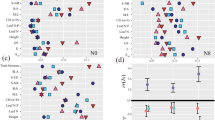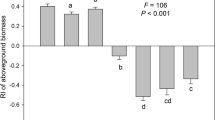Abstract
Changes in resource availability can alter plant growth, the influence of plants on soil characteristics, and, ultimately, plant–soil feedback (PSF). Previous studies often show that invasive plants can outperform native plants under high but not low resource conditions. However, it remains unclear whether under low resource conditions, invaders can outperform natives in the long term by generating more positive or less negative PSFs. Using three non-native invasive and three non-invasive native annual Asteraceae plants, we conducted a two-phase pot experiment, where in the first, conditioning generation plants were grown to induce changes in soil characteristics, and in the second, bioassay generation plants were regrown to evaluate how they respond to these soils. Half of the pots received a nutrient addition treatment in the conditioning generation. We found significant species-specific effects of conditioning on most of the soil characteristics, and some soil characteristics were significantly correlated with bioassay generation biomass of a subset of species, but neither species nor invasive or native status affected bioassay generation biomass. All invasive species generated neutral PSFs across soil nutrient conditions. The native Emilia sonchifolia tended to condition the soil that favored its own growth more than others, and under low nutrient conditions, the native Eclipta prostrata conditioned the soil that disfavored its own growth more than others. These results indicate that invaders may not outperform natives through PSFs under low resource conditions, and increasing resource availability may change the types of PSFs for some native but not invasive plants.



Similar content being viewed by others
References
Bååth E, Frostegård Å, Pennanen T, Hannu F (1995) Microbial community structure and pH response in relation to soil organic matter quality in wood-ash fertilized, clear-cut or burned coniferous forest soils. Soil Biol Biochem 27:229–240. https://doi.org/10.1016/0038-0717(94)00140-v
Bever JD (1994) Feedback between plants and their soil communities in an old field community. Ecology 75:1965–1977. https://doi.org/10.2307/1941601
Blossey B, Notzold R (1995) Evolution of increased competitive ability in invasive nonindigenous plants: a hypothesis. J Ecol 83:887–889. https://doi.org/10.2307/2261425
Blumenthal DM (2006) Interactions between resource availability and enemy release in plant invasion. Ecol Lett 9:887–895. https://doi.org/10.1111/j.1461-0248.2006.00934.x
Bossio DA, Scow KM (1998) Impacts of carbon and flooding on soil microbial communities: phospholipid fatty acid profiles and substrate utilization patterns. Microb Ecol 35:265–278. https://doi.org/10.1007/s002489900082
Callaway RM, Aschehoug ET (2000) Invasive plants versus their new and old neighbors: a mechanism for exotic invasion. Science 290:521–523. https://doi.org/10.1126/science.290.5491.521
Callaway RM, Thelen GC, Rodriguez A, Holben WE (2004) Soil biota and exotic plant invasion. Nature 427:731–733. https://doi.org/10.1038/nature02322
Chen E, Liao H, Chen B, Peng S (2020) Arbuscular mycorrhizal fungi are a double-edged sword in plant invasion controlled by phosphorus concentration. New Phytol 226:295–300. https://doi.org/10.1111/nph.16359
Chiuffo MC, MacDougall AS, Hierro JL (2015) Native and non-native ruderals experience similar plant-soil feedbacks and neighbor effects in a system where they coexist. Oecologia 179:843–852. https://doi.org/10.1007/s00442-015-3399-y
Corkidi L, Rowland DL, Johnson NC, Allen EB (2002) Nitrogen fertilization alters the functioning of arbuscular mycorrhizas at two semiarid grasslands. Plant Soil 240:299–310. https://doi.org/10.1023/A:1015792204633
Crawford KM, Knight TM (2017) Competition overwhelms the positive plant-soil feedback generated by an invasive plant. Oecologia 183:211–220. https://doi.org/10.1007/s00442-016-3759-2
Daehler CC (2003) Performance comparisons of co-occurring native and alien invasive plants: implications for conservation and restoration. Annu Rev Ecol Evol S 34:183–211. https://doi.org/10.1146/annurev.ecolsys.34.011802.132403
Freschet GT, Cornwell WK, Wardle DA, Elumeeva TG, Liu W, Jackson BG, Onipchenko VG, Soudzilovskaia NA, Tao J, Cornelissen JHC (2013) Linking litter decomposition of above- and below-ground organs to plant-soil feedbacks worldwide. J Ecol 101:943–952. https://doi.org/10.1111/1365-2745.12092
Frostegård Å, Tunlid A, Bååth E (2011) Use and misuse of PLFA measurements in soils. Soil Biol Biochem 43:1621–1625. https://doi.org/10.1016/j.soilbio.2010.11.021
Funk JL (2008) Differences in plasticity between invasive and native plants from a low resource environment. J Ecol 96:1162–1173. https://doi.org/10.1111/j.1365-2745.2008.01435.x
Funk JL, Vitousek PM (2007) Resource-use efficiency and plant invasion in low-resource systems. Nature 446:1079–1081. https://doi.org/10.1038/nature05719
Hamman ST, Burke IC, Stromberger ME (2007) Relationships between microbial community structure and soil environmental conditions in a recently burned system. Soil Biol Biochem 39:1703–1711. https://doi.org/10.1016/j.soilbio.2007.01.018
Harrison KA, Bardgett RD (2010) Influence of plant species and soil conditions on plant-soil feedback in mixed grassland communities. J Ecol 98:384–395. https://doi.org/10.1111/j.1365-2745.2009.01614.x
Hinsinger P, Plassard C, Jaillard B (2006) Rhizosphere: a new frontier for soil biogeochemistry. J Geochem Explor 88:210–213. https://doi.org/10.1016/j.gexplo.2005.08.041
Huang QQ, Fan ZW, Li XX, Wang Y, Liu Y, Shen YD (2018) Effects of nutrient addition and clipping on biomass production of invasive and native annual Asteraceae plants. Weed Res 58:318–326. https://doi.org/10.1111/wre.12308
Huang QQ, Pan XY, Fan ZW, Peng SL (2015) Stress relief may promote the evolution of greater phenotypic plasticity in exotic invasive species: a hypothesis. Ecol Evol 5:1169–1177. https://doi.org/10.1002/ece3.1424
Huang QQ, Shen YD, Li XX, Li SL, Fan ZW (2016) Invasive Eupatorium catarium and Ageratum conyzoides benefit more than does a common native plant from nutrient addition in both competitive and non-competitive environments. Ecol Res 31:145–152. https://doi.org/10.1007/s11284-015-1323-x
Johnson NC, Rowland DL, Corkidi L, Allen EB (2008) Plant winners and losers during grassland N-eutrophication differ in biomass allocation and mycorrhizas. Ecology 89:2868–2878. https://doi.org/10.1890/07-1394.1
Keane RM, Crawley MJ (2002) Exotic plant invasions and the enemy release hypothesis. Trends Ecol Evol 17:164–170. https://doi.org/10.1016/s0169-5347(02)02499-0
Klironomos JN (2002) Feedback with soil biota contributes to plant rarity and invasiveness in communities. Nature 417:67–70. https://doi.org/10.1038/417067a
Kulmatiski A, Beard KH, Stevens JR, Cobbold SM (2008) Plant-soil feedbacks: a meta-analytical review. Ecol Lett 11:980–992. https://doi.org/10.1111/j.1461-0248.2008.01209.x
Larios L, Suding KN (2015) Competition and soil resource environment alter plant-soil feedbacks for native and exotic grasses. AoB Plants 7:u77. https://doi.org/10.1093/aobpla/plu077
Liu X, Zhang Y, Han W, Tang A, Shen J, Cui Z, Vitousek P, Erisman JW, Goulding K, Christie P (2013) Enhanced nitrogen deposition over China. Nature 494:459–462. https://doi.org/10.1038/nature11917
MacDougall AS, Rillig MC, Klironomos JN (2011) Weak conspecific feedbacks and exotic dominance in a species-rich savannah. P Roy Soc B-Biol Sci 278:2939–2945. https://doi.org/10.1098/rspb.2010.2730
Manning P, Morrison SA, Bonkowski M, Bardgett RD (2008) Nitrogen enrichment modifies plant community structure via changes to plant-soil feedback. Oecologia 157:661–673. https://doi.org/10.1007/s00442-008-l104-0
Myers RT, Zak DR, White DC, Peacock A (2001) Landscape-level patterns of microbial composition and substrate use in upland forest ecosystems. Soil Sci Soc Am J 65:359e367. https://doi.org/10.2136/sssaj2001.652359x
Olsson P (1999) Signature fatty acids provide tools for determination of the distribution and interactions of mycorrhizal fungi in soil. FEMS Microbiol Ecol 29:303–310. https://doi.org/10.1016/s0168-6496(99)00021-5
Perkins LB, Johnson DW, Nowak RS (2011) Plant-induced changes in soil nutrient dynamics by native and invasive grass species. Plant Soil 345:365–374. https://doi.org/10.1007/s11104-011-0788-9
Perkins LB, Nowak RS (2012) Soil conditioning and plant-soil feedbacks affect competitive relationships between native and invasive grasses. Plant Ecol 213:1337–1344. https://doi.org/10.1007/s11258-012-0092-7
Perkins LB, Nowak RS (2013) Native and non-native grasses generate common types of plant-soil feedbacks by altering soil nutrients and microbial communities. Oikos 122:199–208. https://doi.org/10.1111/j.1600-0706.2012.20592.x
Phillips RP, Brzostek E, Midgley MG (2013) The mycorrhizal-associated nutrient economy: a new framework for predicting carbon-nutrient couplings in temperate forests. New Phytol 199:41–51. https://doi.org/10.1111/nph.12221
Pugnaire FI, Morillo JA, Peñuelas J, Reich PB, Bardgett RD, Gaxiola A, Wardle DA, Van Der Putten WH (2019) Climate change effects on plant-soil feedbacks and consequences for biodiversity and functioning of terrestrial ecosystems. Sci Adv 5:z1834. https://doi.org/10.1126/sciadv.aaz1834
Qin R, Zheng Y, Valiente-Banuet A, Callaway RM, Barclay GF, Pereyra CS, Feng Y (2013) The evolution of increased competitive ability, innate competitive advantages, and novel biochemical weapons act in concert for a tropical invader. New Phytol 197:979–988. https://doi.org/10.1111/nph.12071
Schumacher E, Kueffer C, Edwards P, Dietz H (2009) Influence of light and nutrient conditions on seedling growth of native and invasive trees in the Seychelles. Biol Invasions 11:1941–1954. https://doi.org/10.1007/s10530-008-9371-6
Shivega WG, Aldrich-Wolfe L (2017) Native plants fare better against an introduced competitor with native microbes and lower nitrogen availability. AoB Plants 9:x4. https://doi.org/10.1093/aobpla/plx004
Smith Ramesh LM, Reynolds HL (2017) The next frontier of plant-soil feedback research: unraveling context dependence across biotic and abiotic gradients. J Veg Sci 28:484–494. https://doi.org/10.1111/jvs.12519
Swallow M, Quideau SA, MacKenzie MD, Kishchuk BE (2009) Microbial community structure and function: the effect of silvicultural burning and topographic variability in northern Alberta. Soil Biol Biochem 41:770–777. https://doi.org/10.1016/j.soilbio.2009.01.014
van der Putten WH, Bradford MA, Pernilla Brinkman E, van de Voorde TF, Veen GF (2016) Where, when and how plant-soil feedback matters in a changing world. Funct Ecol 30:1109–1121. https://doi.org/10.1111/1365-2435.12657
van Grunsven RHA, van der Putten WH, Bezemer TM, Tamis WLM, Berendse F, Veenendaal EM (2007) Reduced plant-soil feedback of plant species expanding their range as compared to natives. J Ecol 95:1050–1057. https://doi.org/10.1111/j.1365-2745.2007.01282.x
Verlinden M, De Boeck HJ, Nijs I (2014) Climate warming alters competition between two highly invasive alien plant species and dominant native competitors. Weed Res 54:234–244. https://doi.org/10.1111/wre.12076
Vink SN, Jordan NR, Aldrich-Wolfe L, Huerd SC, Shaeffer CC, Kinkel LL (2017) Soil conditioning affects interactions between native and invasive exotic perennials of semi-natural grasslands. J Appl Ecol 54:1526–1533. https://doi.org/10.1111/1365-2664.12823
Vink SN, Jordan NR, Huerd SC, Shaeffer CC, Kinkel LL, Aldrich-Wolfe L (2015) Soil conditioning effects of native and exotic grassland perennials on the establishment of native and exotic plants. Plant Soil 393:335–349. https://doi.org/10.1007/s11104-015-2498-1
Wei W, Zhu P, Chen P, Huang Q, Bai X, Ni G, Hou Y (2020) Mixed evidence for plant-soil feedbacks in forest invasions. Oecologia 193:665–676. https://doi.org/10.1007/s00442-020-04703-y
Whitaker BK, Rúa MA, Mitchell CE (2015) Viral pathogen production in a wild grass host driven by host growth and soil nitrogen. New Phytol 207:760–768. https://doi.org/10.1111/nph.13369
Zogg G, Zak D, Ringelberg D, Macdonald N, Pregitzer K, White D (1997) Compositional and functional shifts in microbial communities due to soil warming. Soil Sci Soc Am J61:475–481. https://doi.org/10.2136/sssaj1997.03615995006100020015x
Acknowledgements
We thank Huixuan Liao and Fangfang Huang for valuable comments on the manuscript, Fangfang Huang for help with the data analysis, and Xiaoxia Li and Pengdong Chen for help during the experiment. This study was supported by the National Natural Science Foundation of China (31670547, 31971498) and the Central Public-interest Scientific Institution Basal Research Fund for Chinese Academy of Tropical Agricultural Sciences (1630042020012, 1630042019014).
Author information
Authors and Affiliations
Contributions
QH designed the research. YW, GN, and QW performed the experiment and collected the data. YW and QH analyzed the data and wrote the paper. GN and YH improved the paper.
Corresponding author
Ethics declarations
Conflict of interest
The authors declare that they have no conflicts of interest.
Additional information
Communicated by Edith B. Allen.
Rights and permissions
About this article
Cite this article
Wang, Y., Ni, G., Hou, Y. et al. Plant–soil feedbacks under resource limitation may not contribute to the invasion by annual Asteraceae plants. Oecologia 194, 165–176 (2020). https://doi.org/10.1007/s00442-020-04756-z
Received:
Accepted:
Published:
Issue Date:
DOI: https://doi.org/10.1007/s00442-020-04756-z




